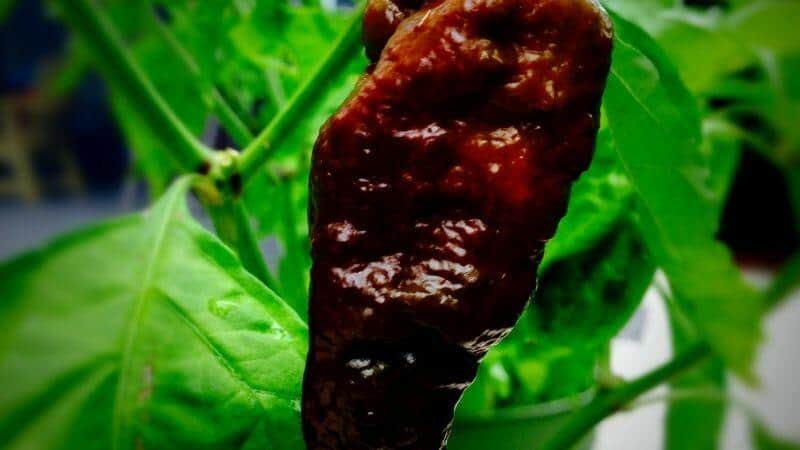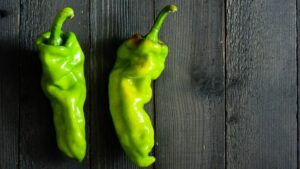You grow ghost peppers for their iconic red color. So discovering black instead can be troubling.
Black discoloration inside ghost peppers is not natural. It’s usually caused by pests, disease, or cultivation issues. Healthy ghost peppers maintain their vibrant red shade inside and out.
This article explores what causes black ghost chilies. You’ll learn:
- Common culprits like pests and sunscald
- Diseases that lead to blackening
- How to prevent and treat black peppers
- When black spots mean full spoilage
- Growing tips for healthy, vibrant red ghost peppers
Understanding what turns these peppers black is key. With proper care, you can avoid this strange color change and keep your ghost chilies looking their fiery best.
So read on to unlock the mysteries of black ghost pepper and cultivate a thriving, robust crop of red-hot beauties. Your taste buds will thank you!
Is Black Normal for Ghost Peppers?
Black is not a natural color for inside a ghost pepper. These chilies are prized for their bright red hue.
When ripe, ghost peppers turn a rich shade of red from skin to seed. Any black coloration means something has gone wrong.
Black spots usually start on the outside of the pepper then penetrate inward. This indicates an external cause like pests, infection, or sunscalding.
While black ghost peppers may be safe to eat, they’ll likely taste off. It’s best to discard any with blackening.
What Turns Ghost Peppers Black?
There are a few common culprits that cause blackened ghost peppers:
Pests and Diseases
- Insects like pepper weevils bore holes and lay eggs in peppers. Their larvae feed inside, causing black decay.
- Bacteria and fungal infections spread from leaves to peppers, destroying tissue.
- Diseases must be controlled quickly to avoid spread.
Blossom End Rot
- Caused by calcium deficiency due to improper watering.
- Begins as a dark spot on the bottom of the pepper which spreads internally.
- Maintaining consistent soil moisture prevents this disorder.
Sun Scalding
- Intense sun exposure can burn peppers, especially when plants are drought stressed.
- Sunscald appears as black, sunken lesions on exposed pepper surfaces.
- Shade cloth helps protect from extreme sunlight and heat.
Varietal Traits
- Some black pepper varieties naturally turn purple-black when ripe.
- Look for a purple undertone to identify these cultivars.
- Color fades to red as maturity progresses.
Preventing Black Ghost Peppers
Stop black ghost peppers before they start with these proactive plant care tips:
- Choose resistant varieties like Nagabhut Jolokia
- Inspect regularly for early signs of pests and disease
- Control weeds, which harbor harmful insects
- Use row cover fabric to exclude insect pests
- Apply calcium supplements to avoid blossom end rot
- Water carefully and evenly; about 1” per week
- Use shade cloth in intense sunlight
When Does Blackening Mean Spoilage?
Not all black ghost peppers are unsafe to eat. But certain signs indicate full spoilage:
- Very soft, wrinkled texture
- Dark brown or black splotches
- Visible mold growth
- Foul, bland smell
Completely rotten peppers should be discarded and plants promptly removed to prevent spread.
The Colors of Ghost Peppers
Ghost peppers can ripen to more shades than just red. The color of the pepper provides clues about its maturity and spiciness level.
Some common ghost pepper colors include:
Green
- Unripe ghost peppers are green.
- They will ripen further if left on the plant.
- Green ghosts have milder heat compared to ripe colors.
Yellow
- As ghost peppers start to ripen, they turn yellow.
- Yellow ghosts are moderately spicy, halfway between green and red.
Orange
- Bright orange peppers are almost fully ripe.
- Orange ghost chilies pack a punch but not quite as much as red.
Red
- Fully ripe ghost peppers turn a rich, bright red.
- This is the ideal stage for peak spiciness and flavor.
- Red chilies should be promptly harvested.
Purple
- Some ghost pepper varietals ripen to a deep purple-red.
- These unique strains are just as hot as traditional red.
Black
- As explained above, black indicates disease or damage.
- No healthy ghost pepper will turn truly black when ripe.
So in summary, vibrant, ripe colors like red, orange, or purple signify flavorful ghost chilies at their spicy best. Green and yellow peppers are still tasty but milder. And black is never good!
Growing Healthy Red Ghost Peppers
Follow these best practices to cultivate vibrant, robust ghost pepper plants:
- Plant in warm soil (65-85°F) in full sun
- Space 18-24” apart in well-draining loam
- Fertilize monthly with balanced vegetable blend
- Water 1-2” per week; avoid wet leaves
- Stake stems for support once fruited
- Monitor for pests and treat early
- Harvest fully red peppers promptly
With attentive care, your ghost chilies will bear abundant, beautiful red fruit inside and out. Never settle for black!
Frequently Asked Questions
What does it mean if my pepper is black?
While some pepper varieties naturally turn black when ripe, black color in most chilies indicates a problem like sunburn, blossom end rot, or insect damage.
Should you eat peppers with black spots?
It’s best not to eat peppers that have any black spots, lesions, or decay since this will negatively impact flavor. Blackening can also indicate harmful bacteria growth.
What type of chili pepper is naturally black?
Some black pepper varieties like the Black Cobra are harvested black before ripening further to red. Their dark color signals maturity rather than disease.
Conclusion
When you slice open a ghost pepper and see black instead of vibrant red, something is wrong. With preventative care and prompt treatment of pests and disease, you can keep your ghost chilies looking and tasting their best.





